instrument panel Peugeot Bipper 2015 Owner's Manual
[x] Cancel search | Manufacturer: PEUGEOT, Model Year: 2015, Model line: Bipper, Model: Peugeot Bipper 2015Pages: 192, PDF Size: 7.97 MB
Page 4 of 192
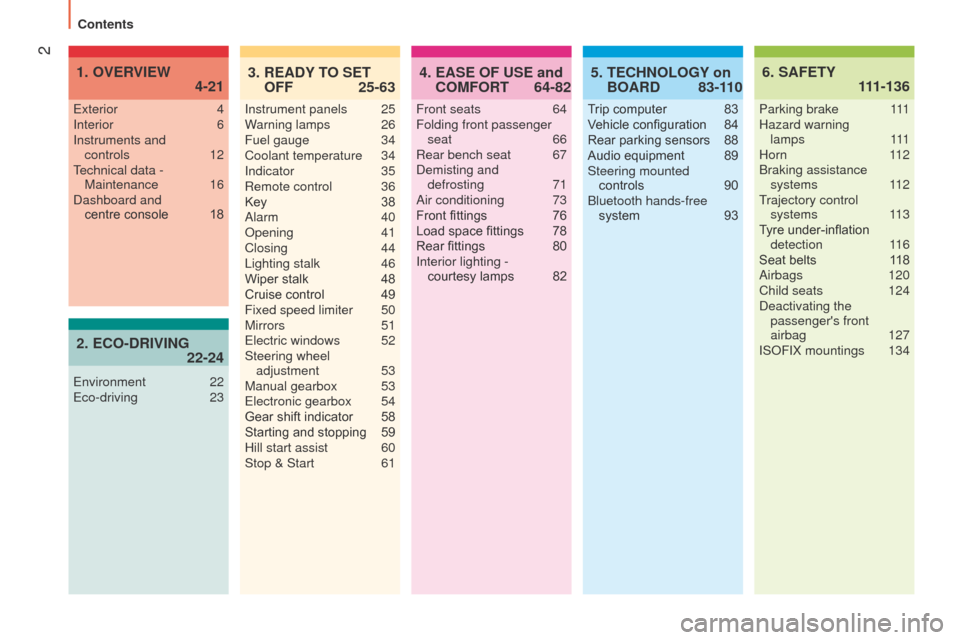
2
Bipper_en_Chap00a_sommaire_ed02-2014
EASE OF USE and
COMFORT
4. 64-82 SAFETY
6.
111-136
Front seats 64
Folding front passenger seat
66
Rear bench seat
67
Demisting and defrosting
71
Air conditioning
73
Front fittings
76
Load space fittings
78
Rear fittings
80
Interior lighting - courtesy lamps
82
e
xterior
4
Interior
6
Instruments and controls
12
technical data - Maintenance
16
Dashboard and centre
console
18
OVERVIEW
1.
4-21
Parking brake 1 11
Hazard warning lamps
111
Horn
112
Braking assistance systems
112
trajectory control systems
113
Tyre under-inflation detection
1
16
Seat belts
1
18
Airbags
120
Child seats
124
Deactivating the passenger's front
airbag
127
ISOFIX mountings
134
TECHNOLOGY on
BOARD
5. 83-1
10
Trip computer 83
V ehicle configuration 84
Rear parking sensors
88
Audio equipment
89
Steering mounted controls
90
Bluetooth hands-free system
93
READY TO SET
OFF
3.
25-63
Instrument panels 25
W arning lamps 26
Fuel gauge
34
Coolant temperature
34
Indicator
35
Remote control
36
Key
38
Alarm
40
Opening
41
Closing
44l
ighting stalk
46
Wiper stalk
48
Cruise control
49
Fixed speed limiter
50
Mirrors
51
e
lectric windows
52
Steering wheel adjustment
53
Manual gearbox
53e
lectronic gearbox
54
Gear shift indicator
58
Starting and stopping
59
Hill start assist
60
Stop & Start
61
ECO-DRIVING
2.
22-24
environment 22e
co-driving 23
Contents
Page 14 of 192
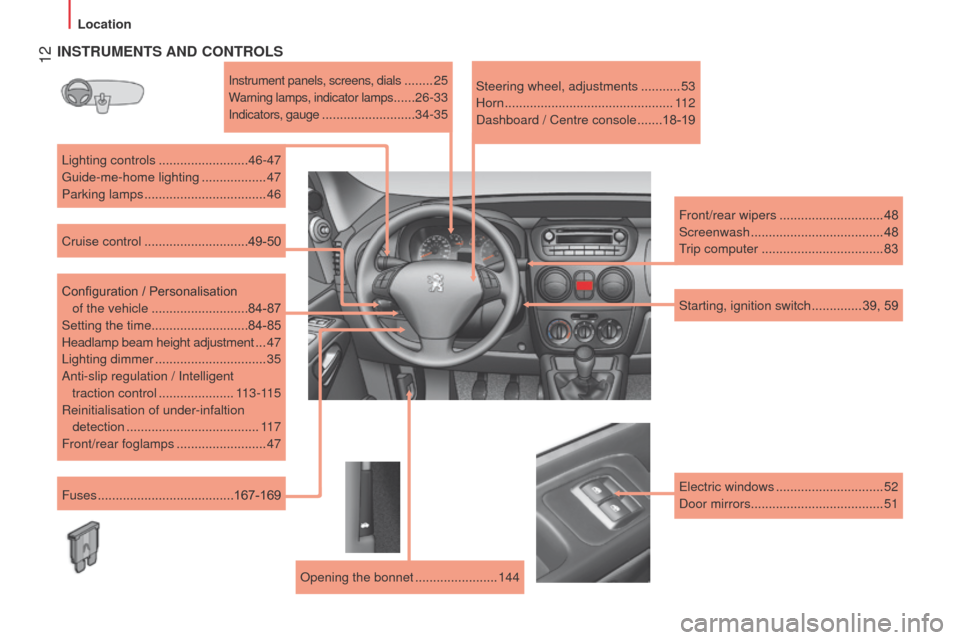
12
Bipper_en_Chap01_vue-ensemble_ed02-2014
INSTRUMENTS AND CONTROLS
Instrument panels, screens, dials ........25
Warning lamps, indicator lamps ......26-33
Indicators, gauge .......................... 34-35Steering wheel, adjustments
...........
53
Horn ...............................................
11 2
Dashboard / Centre console .......18-19
l
ighting controls
......................... 46-47
g
uide-me-home lighting
.................. 47
Parking lamps
.................................. 46
Cruise control
............................. 49-50
Configuration / Personalisation
of the vehicle
...........................84-87
Setting the time........................... 84-85
Headlamp beam height adjustment
... 47
l
ighting dimmer
............................... 35
Anti-slip regulation / Intelligent traction control
..................... 113-115
Reinitialisation of under-infaltion detection
.......
.............................. 11 7
Front/rear foglamps
......................... 47
Fuses
...................................... 167-169
Opening the bonnet
....................... 144 Starting, ignition switch
..............39, 59
Front/rear wipers
.............................48
Screenwash
.....................................48
trip computer
..................................83
e
lectric windows
..............................52
Door mirrors
.....................................51
Location
Page 16 of 192
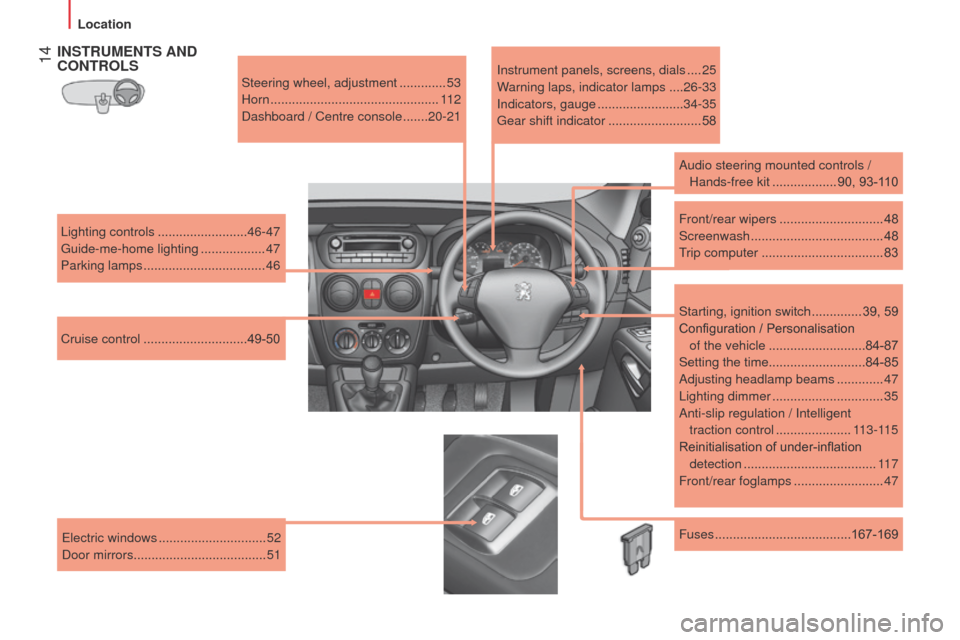
14
Bipper_en_Chap01_vue-ensemble_ed02-2014
INSTRUMENTS AND
CONTROLS
Steering wheel, adjustment .............53
Horn ............................................... 11 2
Dashboard / Centre console
.......20-21
l
ighting controls
......................... 46-47
g
uide-me-home lighting
.................. 47
Parking lamps
.................................. 46
Cruise control
............................. 49-50 Instrument panels, screens, dials
....
25
Warning laps, indicator lamps .... 26-33
Indicators, gauge
........................ 34-35
g
ear shift indicator
..........................58
Audio steering mounted controls / Hands-free kit
..................90, 93-110
Front/rear wipers
.............................48
Screenwash
.....................................48
trip computer
..................................83
Starting, ignition switch
..............39, 59
Configuration / Personalisation
of the vehicle
...........................84-87
Setting the time........................... 84-85
Adjusting headlamp beams
.............47
l
ighting dimmer
...............................35
Anti-slip regulation / Intelligent traction control
.....................113-115
Reinitialisation of under-inflation detection
.......
..............................11 7
Front/rear foglamps
.........................47
Fuses
......................................167-169
e
lectric windows
.............................. 52
Door mirrors
..................................... 51
Location
Page 20 of 192

18
Bipper_en_Chap01_vue-ensemble_ed02-2014
Dashboard / Centre console
1. Door mirror controls.
2.
Front door glass demisting vent.
3.
Adjustable side vent.
4.
l ighting and direction indicator control
stalk.
5.
Instrument panel.
6.
Steering mounted audio system controls.
Bluetooth hands-free system.
7.
W
ash / Wipe /
trip computer control stalk.
8.
Centre adjustable air vents.
9.
Audio system.
10.
Windscreen demisting vent.
11
.
Passenger's front airbag.
12.
e lectric window controls.
13.
g love box.
14.
Heating / air conditioning controls.
15.
g ear lever.
16.
Ashtray.
17.
Cigarette lighter
.
18.
12V accessory socket.
19.
Parking brake.
20.
Ignition switch and steering lock.
21.
Driver's front airbag.
Horn.
22.
Steering wheel adjustment control.
23.
Bonnet release lever
.
24.
Fusebox.
25.
Cruise control.
Presentation
Page 22 of 192
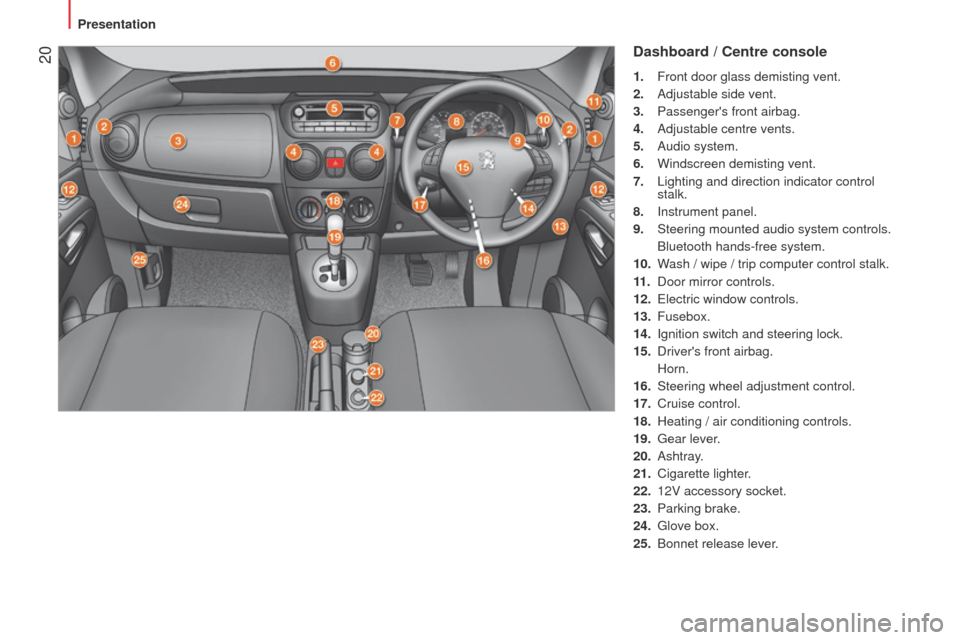
20
Bipper_en_Chap01_vue-ensemble_ed02-2014
Dashboard / Centre console
1. Front door glass demisting vent.
2.
Adjustable side vent.
3.
Passenger's front airbag.
4.
Adjustable centre vents.
5.
Audio system.
6.
Windscreen demisting vent.
7.
l ighting and direction indicator control
stalk.
8.
Instrument panel.
9.
Steering mounted audio system controls.
Bluetooth hands-free system.
10.
W
ash / wipe / trip computer control stalk.
11 .
Door mirror controls.
12.
e lectric window controls.
13.
Fusebox.
14.
Ignition switch and steering lock.
15.
Driver's front airbag.
Horn.
16.
Steering wheel adjustment control.
17.
Cruise control.
18.
Heating / air conditioning controls.
19.
g ear lever.
20.
Ashtray.
21.
Cigarette lighter
.
22.
12V accessory socket.
23.
Parking brake.
24.
g love box.
25.
Bonnet release lever
.
Presentation
Page 25 of 192

23
Bipper_en_Chap02_eco-conduite_ed02-2014
ECO-DRIVING
eco-driving is a range of everyday practices that allow the motorist to o\
ptimise their fuel consumption and CO2 emissions.
Optimise the use of your gearbox
With a manual gearbox, move off gently and change up without
waiting. During acceleration change up early.
With an automatic or electronic gearbox, give preference to automatic
mode and avoid pressing the accelerator pedal heavily or suddenly.
t
he gear shift indicator invites you engage the most suitable gear: as
soon as the indication is displayed in the instrument panel, follow it
straight away.
For vehicles fitted with an electronic or automatic gearbox, this
indicator appears only in manual mode.
Drive smoothly
Maintain a safe distance between vehicles, use engine braking rather
than the brake pedal, and press the accelerator progressively.
t
hese
practices contribute towards a reduction in fuel consumption and CO
2
emissions and also helps reduce the background traffic noise.
If your vehicle has cruise control, make use of the system at speeds
above 25 mph (40 km/h) when the traffic is flowing well.
Control the use of your electrical equipment
Before moving off, if the passenger compartment is too warm, ventilate it
by opening the windows and air vents before using the air conditioning.
Above 30 mph (50 km/h), close the windows and leave the air vents
open.
Remember to make use of equipment that can help keep the
temperature in the passenger compartment down (sunroof and window
blinds...).
Switch off the air conditioning, unless it has automatic regulation, as
soon as the desired temperature is attained.
Switch off the demisting and defrosting controls, if not automatic.
Switch off the heated seat as soon as possible.
Switch off the headlamps and front foglamps when the level of light
does not require their use.
Avoid running the engine before moving off, particularly in winter; your
vehicle will warm up much faster while driving.
As a passenger, if you avoid connecting your multimedia devices
(film, music, video game...), you will contribute towards limiting the
consumption of electrical energy, and so of fuel.
Disconnect your portable devices before leaving the vehicle.
2
ECO-DRIVING
Motoring & Environment
Page 27 of 192

25
Bipper_en_Chap03_pret-a-partir_ed02-2014
INSTRUMENT PANELS
1. Distance recorder in miles / kilometres.
2. Screen.
3.
Fuel gauge.
4.
Coolant temperature.
5.
Rev counter
.
Instrument panel with level 1 screen Instrument panel with level 2 screen
Instrument panel level 1 screen
- time.
-
Miles / Kilometres travelled.
-
t
rip computer (range, fuel consumption,
average speed).
-
Headlamp beam height.
-
Programmable overspeed warning.
-
g ear shift indicator.
-
Stop & Start.
-
Activation/ Deactivation of the
passenger's front airbag.
Instrument panel level 2 screen
- time.
-
Date.
-
Radio. -
Miles / Kilometres travelled.
-
Modes and gear engaged on the
electronic gearbox,
- t
rip computer (ambient temperature,
range, fuel consumption, average speed
-
Headlamp beam height,
-
Programmable overspeed warning,
-
Selection of the display language,
-
g ear shift indicator.
-
Stop & Start.
-
Activation/ Deactivation of the
passenger's front airbag.
- State and alert messages for vehicle
functions.
3
READY TO SET OFF
Instruments and controls
Page 35 of 192
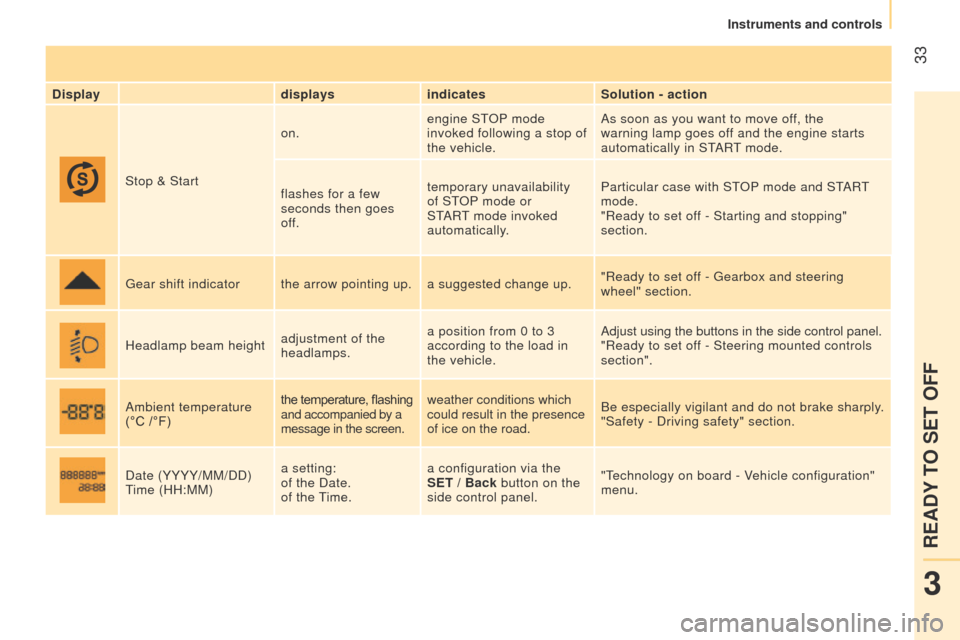
33
Bipper_en_Chap03_pret-a-partir_ed02-2014
Displaydisplaysindicates Solution - action
Stop & Start on.
engine S
t
OP
mode
invoked following a stop of
the vehicle. As soon as you want to move off, the
warning lamp goes off and the engine starts
automatically in S
t
ARt mode.
flashes for a few
seconds then goes
off. temporary unavailability
of S
t
OP
mode or
S
t
ARt mode invoked
automatically. Particular case with S
t
OP
mode and S t
ARt
mode.
"Ready to set of
f - Starting and stopping"
section.
g
ear shift indicator the arrow pointing up. a suggested change up. "Ready to set off -
g earbox and steering
wheel" section.
Headlamp beam height adjustment of the
headlamps.a position from 0 to 3
according to the load in
the vehicle. Adjust using the buttons in the side control panel.
"Ready to set off - Steering mounted controls
section".
Ambient temperature
(°C /°F) the temperature, flashing
and accompanied by a
message in the screen.weather conditions which
could result in the presence
of ice on the road.
Be especially vigilant and do not brake sharply.
"Safety - Driving safety" section.
Date (YYYY/MM/DD)
time (HH:MM) a setting:
of the Date.
of
the t
ime.a configuration via the
SET / Back button on the
side control panel. "
t
echnology on board - V
ehicle configuration"
menu.
3
READY TO SET OFF
Instruments and controls
Page 36 of 192
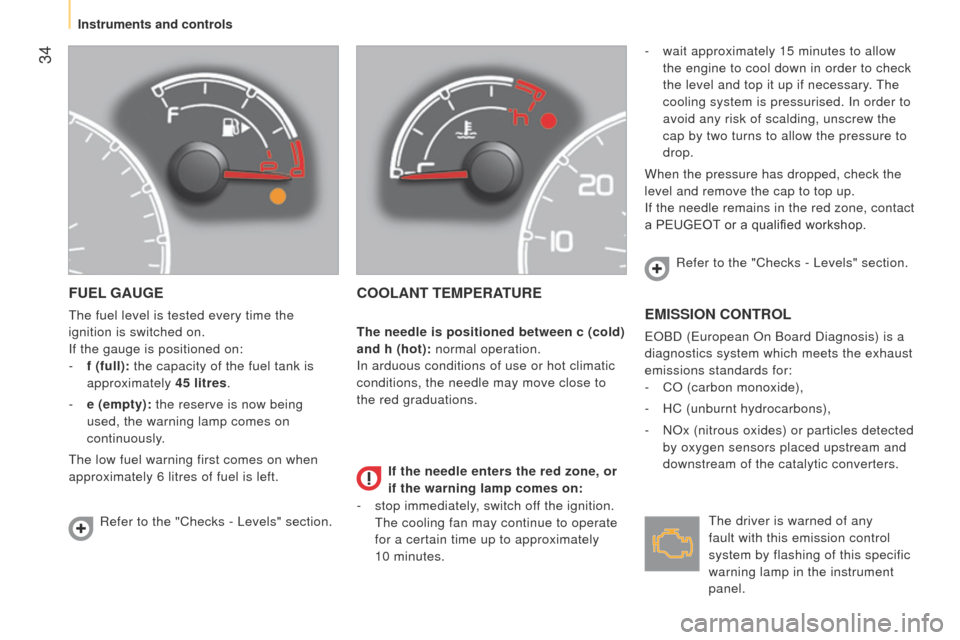
34
Bipper_en_Chap03_pret-a-partir_ed02-2014
FUEL GAUGE
the fuel level is tested every time the
ignition is switched on.
If the gauge is positioned on:
-
f (full):
the capacity of the fuel tank is
approximately 45 litres.
-
e (empty):
the reserve is now being
used, the warning lamp comes on
continuously.
t
he low fuel warning first comes on when
approximately 6 litres of fuel is left.
COOLANT TEMPERATURE
- wait approximately 15 minutes to allow
the engine to cool down in order to check
the level and top it up if necessary.
t
he
cooling system is pressurised. In order to
avoid any risk of scalding, unscrew the
cap by two turns to allow the pressure to
drop.
When the pressure has dropped, check the
level and remove the cap to top up.
If the needle remains in the red zone, contact
a PEUGEOT or a qualified workshop.
EMISSION CONTROL
eOBD (european On Board Diagnosis) is a
diagnostics system which meets the exhaust
emissions standards for:
-
CO (carbon monoxide),
-
HC (unburnt hydrocarbons),
-
NOx (nitrous oxides) or particles detected
by oxygen sensors placed upstream and
downstream of the catalytic converters.
Refer to the "Checks -
l
evels" section. Refer to the "Checks -
l evels" section.
t
he driver is warned of any
fault with this emission control
system by flashing of this specific
warning lamp in the instrument
panel.
If the needle enters the red zone, or
if the warning lamp comes on:
The needle is positioned between c (cold)
and h (hot): normal operation.
In arduous conditions of use or hot climatic
conditions, the needle may move close to
the red graduations.
-
stop immediately
, switch off the ignition.
t
he cooling fan may continue to operate
for a certain time up to approximately
10
minutes.
Instruments and controls
Page 37 of 192
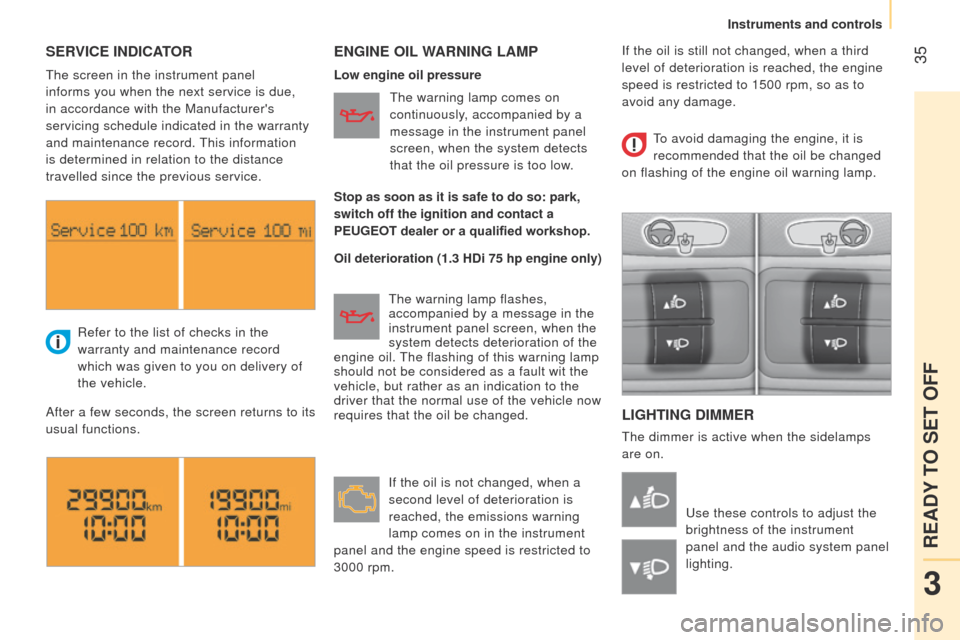
35
Bipper_en_Chap03_pret-a-partir_ed02-2014
SERVICE INDICATORENGINE OIL WARNING LAMP
L IGHTING DIMMER
the dimmer is active when the sidelamps
are on.
Refer to the list of checks in the
warranty and maintenance record
which was given to you on delivery of
the vehicle.
After a few seconds, the screen returns to its
usual functions.
u
se these controls to adjust the
brightness of the instrument
panel and the audio system panel
lighting.
t
he screen in the instrument panel
informs you when the next service is due,
in accordance with the Manufacturer's
servicing schedule indicated in the warranty
and maintenance record.
t
his information
is determined in relation to the distance
travelled since the previous service. Low engine oil pressure
Oil deterioration (1.3 HDi 75 hp engine only)
t
he warning lamp comes on
continuously, accompanied by a
message in the instrument panel
screen, when the system detects
that the oil pressure is too low.
t
he warning lamp flashes,
accompanied by a message in the
instrument panel screen, when the
system detects deterioration of the
engine oil.
t
he flashing of this warning lamp
should not be considered as a fault wit the
vehicle, but rather as an indication to the
driver that the normal use of the vehicle now
requires that the oil be changed.
If the oil is not changed, when a
second level of deterioration is
reached, the emissions warning
lamp comes on in the instrument
panel and the engine speed is restricted to
3000 rpm.
to avoid damaging the engine, it is
recommended that the oil be changed
on flashing of the engine oil warning lamp.
Stop as soon as it is safe to do so: park,
switch off the ignition and contact a
PEUGEOT dealer or a qualified workshop. If the oil is still not changed, when a third
level of deterioration is reached, the engine
speed is restricted to 1500 rpm, so as to
avoid any damage.
3
READY TO SET OFF
Instruments and controls